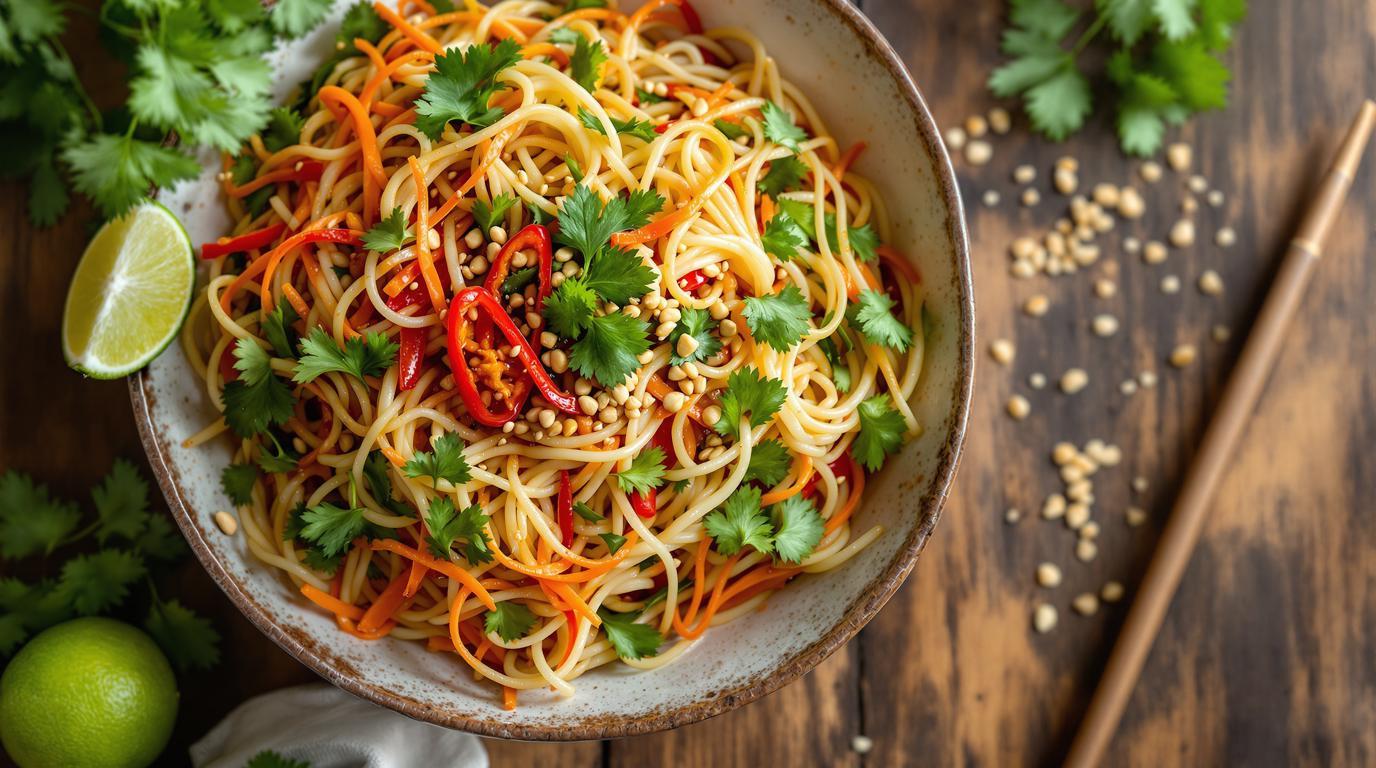There’s something magical about the way a bowl of chilled noodles can rescue you on a sweltering summer day. I discovered this firsthand during my culinary travels through Southeast Asia, where I found local grandmothers preparing variations of cold noodle salads in open-air markets as temperatures soared. These weren’t fancy restaurant dishes but practical, economical solutions to beat the heat while delivering incredible flavor. Today I’m sharing my take on this classic cooling dish that costs just pennies per serving but delivers restaurant-worthy results.
The Perfect Asian Noodle Salad: Cool, Crisp & Budget-Friendly 🥢
This noodle salad strikes the perfect balance between authentic technique and practical home cooking. The beauty lies in its versatility—you can adapt it based on what’s in your refrigerator while maintaining the essential balance of sweet, sour, salty, and spicy elements that defines Southeast Asian cuisine.
Unlike heavy mayo-based pasta salads, this refreshing dish relies on a vibrant dressing that coats each strand without weighing it down. The result is light yet satisfying—exactly what your body craves when temperatures rise. I’ve seen similar dishes served from Bangkok to Hanoi, each with regional tweaks that make them unique.
Essential Ingredients: Building Layers of Flavor 🌱
Start with 7 oz (200g) of rice noodles as your base—these delicate, translucent noodles absorb flavors beautifully while remaining light on the palate. Unlike wheat noodles, they won’t continue absorbing dressing and becoming gummy when chilled.
The vegetable combination provides contrasting textures and colors: 1 cup shredded carrots, 1 cup julienned red bell peppers, ¼ cup chopped cilantro, and 4 thinly sliced green onions. Feel free to add 1 cucumber (seeded and julienned) and a cup of fresh bean sprouts for extra crunch.
The magic happens in the dressing—whisk together 3 tablespoons soy sauce, 3 tablespoons rice vinegar, 2 teaspoons toasted sesame oil, 2 teaspoons Sriracha, 2 tablespoons natural peanut butter, 2 teaspoons sugar, a 1-inch piece of grated fresh ginger, and 2 minced garlic cloves.
Chef’s Note: The order matters when building your dressing! I always start by mashing the ginger and garlic with a mortar and pestle to release their aromatic oils before whisking in the liquid ingredients. Add the peanut butter last, whisking vigorously until emulsified—this prevents clumping and ensures silky texture.
Step-by-Step Method: Timing Is Everything ⏱️
- Bring a large pot of salted water to a rolling boil. Add rice noodles and cook until just tender, about 3-4 minutes (or according to package directions).
- Immediately drain and rinse under cold running water until completely chilled. This stops the cooking process and removes excess starch that would cause clumping.
- Pat noodles dry with a clean kitchen towel—this seemingly small step prevents your dressing from becoming diluted.
- In a large bowl, combine all vegetables and herbs.
- Whisk together all dressing ingredients until smooth and emulsified.
- Add noodles to vegetables and pour dressing over, tossing gently with tongs or clean hands until everything is evenly coated.
- Refrigerate for at least 30 minutes (ideally 60) to allow flavors to meld.
Before serving, taste and adjust seasoning—you might want an extra splash of soy sauce or rice vinegar depending on your preference. Top with a handful of chopped roasted peanuts and lime wedges for squeezing over individual portions.
Budget-Friendly Adaptations Without Sacrificing Flavor 💰
If peanut butter is outside your budget, substitute 1 tablespoon of tahini or simply omit it entirely for a lighter, more vinaigrette-style dressing. No Sriracha? Use a pinch of red pepper flakes. Sunflower seeds make an excellent stand-in for peanuts at nearly half the price.
This salad costs roughly $3 per serving—less than a fancy coffee—but delivers restaurant-quality results. The recipe also shines as a vehicle for leftover protein; simply add ½ cup cubed tofu or leftover grilled chicken if desired. I’ve created variations with protein-packed tuna that work beautifully too.
Regional Variations Worth Trying 🌏
For a more authentic Thai version, swap lime juice for tamarind paste and add Thai basil. Vietnamese-inspired? Add mint and more herbs, similar to how I approach my spicy grape snacks with unexpected herb combinations. Each variation creates an entirely new experience while maintaining the refreshing quality that makes this dish special.
Pair your noodle salad with smooth Southern-style iced tea for the ultimate cooling meal, or follow it with a no-bake berry parfait for a complete summer dinner that won’t heat up your kitchen.
The beauty of grandmother-style cooking lies in its practicality and wisdom. This salad—economical, cooling, and nourishing—embodies that spirit perfectly. Like grandma-inspired overnight oats, it proves that sometimes the most satisfying dishes are also the most sensible. Your kitchen may not have the ambiance of a Southeast Asian market, but with this recipe, you’ll capture the authentic flavors that have cooled generations through countless summer heat waves.
